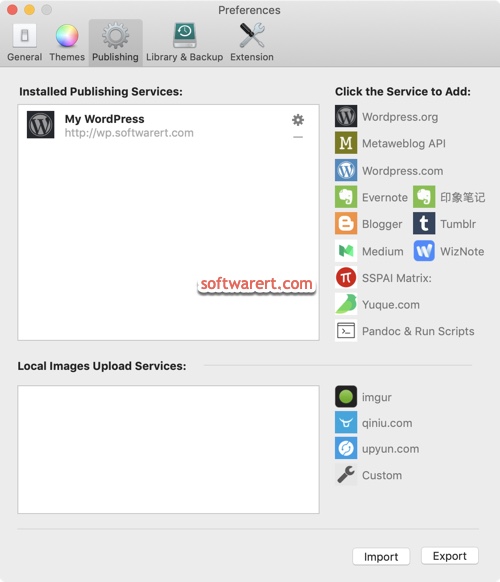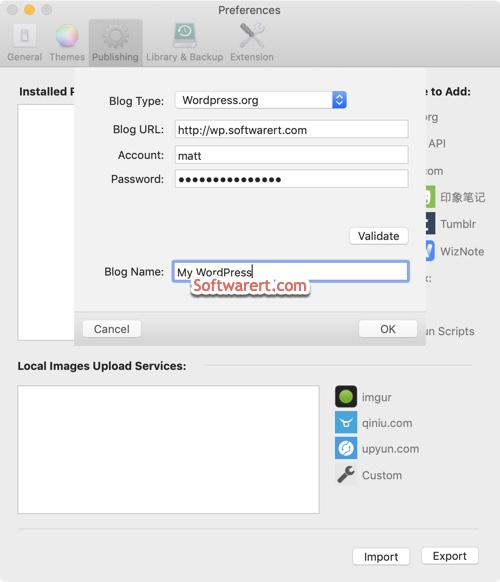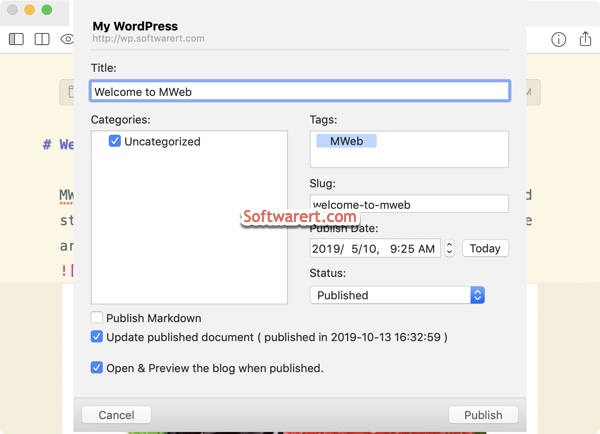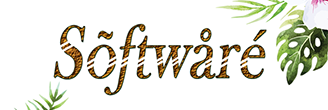MWeb is a professional markdown writing, note taking and static blog generator App for Mac, iPhone, iPad. If you are a writer, blogger, you will find it is very easy to write and organize using this writing app. Today, we will show you how to add WordPress, the most popular blogging CMS and site builder, to MWeb and then publish your local articles, posts created with MWeb to your production WordPress blog or site.
MWeb has the built-in Publishing Services which allows users to easily publish documents to WordPress, services that support the Metaweblog API protocol, WordPress.com, Evernote, Blogger, Medium, Tumblr.
Adding WordPress to MWeb on Mac
Launch the writing software on your Mac. click MWeb from the top menu bar, choose Preferences from the drop-down menu to open the Preferences dialog. Then switch from General to Publishing tab, you will see a screen like this. Here you can find various third-party publishing services like WordPress, Evernote, Blogger, Tumblr, Medium, WizNote, etc.

Click WordPress.org from the Click the Service to Add column at the right hand side. Then input your WordPress site credentials as folowing:

WordPress.org VS WordPress.com
The former is the self-hosted wordpress service. You have to buy a web space and create your WordPress site on it first.
- Blog Type: WordPress.org;
- Blog URL: your site URL, domain name, starting with http://;
- Account: WordPress dashboard login username;
- Password: WordPress dashboard login password;
- Blog Name: give your WordPress site or blog an unique name in the writing app.
Click Validate button to validate your WordPress site connection and admin login. Hit OK button to add the WordPress account to MWeb app on your Mac.
Publish articles from MWeb to WordPress
Run MWeb on Mac. Open the document you want to publish, click Publish from the top menu bar, then choose your WordPress site from the lower section of the drop-down menu. You will see a screen like this.

Type in your post title, select a category, input tags for the post, optionally change its slug, date, etc. Hit the Publish button at the bottom right corner to upload the document to your production site.
Uploading Images from MWeb to WordPress
Insert images to your documents in MWeb and they will be uploaded to your WordPress site when you publish the documents or text from MWeb to WordPress automatically. No need to upload images to WordPress separately through admin panel or FTP.
You can find the uploaded images from WordPress Dashboard > Media > Library. They will be organized into month- and year-based folders by default. This is the default setting WordPress manage your uploads. You can change it from Dashboard > Settings > Media.
What image formats are supported?
Based on my own experience, MWeb supports common image formats like JPG, JPEG and PNG. Tried to insert a HEIC picture, but it was not published from MWeb to WordPress.
How to update an existing WordPress post using MWeb?
Once a post was published from MWeb to WordPress and you made changes to the article in MWeb, how to update the existing WordPress post using MWeb? Simply select and publish the same post again, MWeb will detect if there is a similar post on your remote site already. This time you will see a checkbox “Update published document”. By default this option is checked, so when you publish the article, the published post on your WordPress site will be updated. If you uncheck it, a new article will be published.
Optimize image Alt tags for SEO
Alt text strengthens the message of your articles with search engine spiders. Spiders can’t read your images, instead they will read the image alt attribute. Also the alt tags are good for screen readers. Thus they can improve the accessibility of your website as well.
Inline image syntax looks like this:
When you insert an image to a document, the image name will be used as the alt text automatically by MWeb. You can however manually change or optimize it.
